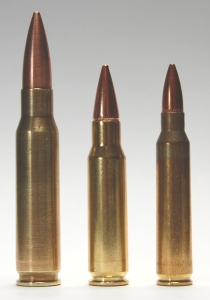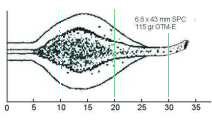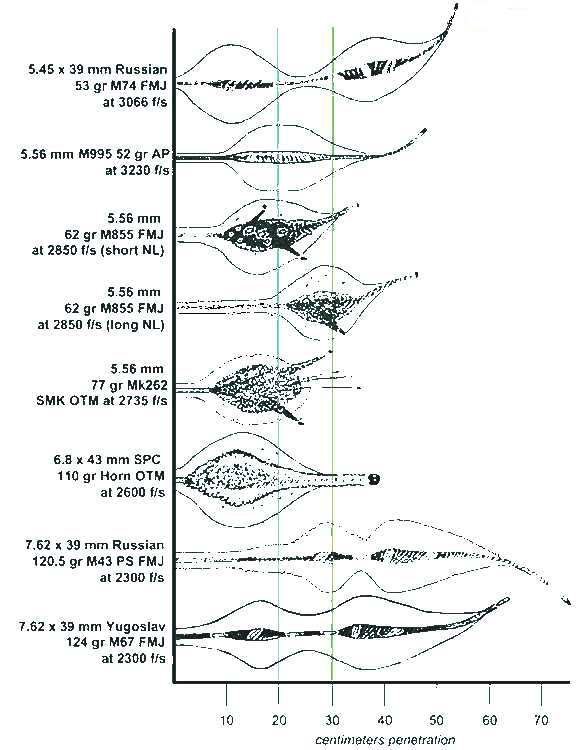 |
|
7.62 x 51, 6.8 x 43, and 5.56 x 45 |
In my humble opinion, the 6.8 x 43 mm / 6.8 SPC cartridge is one of those happy "accidents" whose performance potential is all out of proportion to its design--like the old DC-3 aircraft or the 1911 pistol. I have been following its growth for some time now and thought it was time for a dedicated page about it on my site.
In The Beginning
The 6.8 SPC cartridge began with a search for a cartridge that would fit in astandard AR platform and provide better terminal ballistics at both short and long ranges than the 5.56 x 45 mm. The original research for an improved M4 type weapons system was undertaken by MSgt Steve Holland, 5th Special Forces Group who initiated the search for a new cartridge. Army researchers settled on the old .30 Remington case necked down to various calibers. In their estimation the best performance came with a .277 diameter bullet. Troy Lawton (Chief Ballistics Technician) and Cris Murray (Service Rifle and R&D Gunsmith) of the USAMU (Army Marksmanship Unit) assisted in developing loads, and built the test rifles for the project. Art Kalwas, the owner of Silver State Armory has also been heavily involved in the development and initial production runs of 6.8 SPC ammunition.
The 6.8 mm SPC cartridge is roughly mid-way between the M855 5.56 mm and the 7.62 mm NATO rounds. It is more potent at all ranges than the 5.56 mm while still allowing a light, compact weapons system on the AR platform. It was preferred over several competing cartridge designs because its shape allows better feeding in automatic weapons and its size is more compatible compatible with "AR" and other 5.56 mm platforms magazine design.. The original military ammunition and chamber design gave velocities in the range of 2650 - 2700 f/s from a 16" barrel with a 115 gr bullet.
Military ammunition and commercial ammunition from Hornady and Silver State Armory use the small rifle primer while Remington ammunition uses large rifle primers for some unknown reason.
If it wasn't for the requirement to fit in a standard 5.56 x 45mm AR based firearm (which requires a maximum cartridge OAL of 2.26", a better choice might have been to use a slightly longer case of about 1.85 inches (making it a 6.8 x 47 mm round) of about 2.5" in length. This would have resulted in a slightly longer round with significantly increased ballistics, approaching a 115 gr bullet at close to 2900 f/s or a 110 gr at close to 3,000 f/s.
Current Status
When Reminton got the initial contract for ammunition production they decided to standardize the cartridge as a SAAMI design but the chamber drawing they supplied SAAMI contained an error in the chamber mouth angle and throat area that when combined with original GI spec ammunition created extremely high and dangerous pressures. Unfortunately a lot of commercial rifles had their chambers cut with the mis-dimensioned reamers. The mis-dimensions throat mouths are specified to have a 45 degree angle in the drawing actually have about an 80 degree angle when the dimensions are followed, which has caused brass shaving from the bullet and a build up in the throat area which caused pressure spikes. Current commercial ammo is loaded down to about 2550 f/s from a 16" barrel in deference to the chamber problems. There has been a version "II" SAAMI chamber specification (a.k.a.SPC II) developed with basically more freebore and a large neck area, that allow full pressure GI ammunition to be fired safely but the chamber mouth angle problem still exists. Supposedly, the original SPC II reamers have been corrected to a 45 degree angle but mis-cut chambers still exist. The so-called "DMR" (Designated Marksman Rifle) chamber, designed by Harrison Beene helped to correct the issue and allowed the original full performance level the cartridge. It also claimed improved accuracy but results have varied. However both chamber and brass specifications seem to be in a state of flux at this time and the "in" chamber is reportedly an SPC II+ which has a slightly differnt throat..
To view the various chamber designs click here.
Probably the most original research on 6.8 SPC performance possibilities was done by Messsr. Harrison Beene of AR 15 Performance (www.ar15performance.com), and Tim Welter. They have been exploring chamber and rifling designs for some time now as well as powder compatibility and loading data using a PressureTrace unit for pressure measurements since it gives highly detailed real-time data. (For more on PressureTrace see www.shootingsoftware.com/pressure.htm).
Using the "DMR" chamber, a 1:11 twist 5R rifled barrel, and specially designed high velocity 80 gr copper bullets (part number 270080HV063) from GS Custom Bullets in South Africa (www.gsgroup.co.za) velocities close to 3400 f/s have been achieved, and with an 85 gr Barnes TSX copper bullet velocities close to 3200 f/s have been achieved from 16" barrels--without high pressures using various rifling formats. By the way, Harrison also makes very high quality 6.8 SPC uppers for the AR platform available anywhere. Contact him for more details through his website.
SAAMI specs call for a max average pressure of 55 k psi but the military loading runs around 58 k psi. It is currently undergoing field testing by regular and special operations units and is extremely well liked and has been adopted by numerous agencies.
6.8 SPC External Ballistics
The 6.8 SPC using the current 115 gr Sierra bullet (not a particularly efficient bullet ballistically (G1 = .324/G7 = .162) shows trajectory close to the M855 and the 7.62 NATO. It delivers greater energy at all ranges than either the 5.56 or 7.62 x 39 rounds.
Using a purpose developed more efficient shape or even switching to the Hornady bullet would bring the G7 BC up to .170 - .172 and provide even better trajectory. (Using the Hornady 110 gr OTM (G1 = .360/G7=.180) at 2675 f/s puts the 1000 yard drop at 572 and the path at -493". and the 110 gr Hornady V-Max (G1 - .370/G7=.185) at 557" and 478" respectively, using the ballistic assumptions in the table below below.) There are bullets under investigation that have even higher BCs and work is being done with powder formulations and on the chamber design that increase muzzle velocity significantly. Comparative ballistics are given below. A 250 yard zero is assumed for all loads and velocities are based upon the GI specifications.
| M855 Ball from 16" M4 | 115 gr OTM-E from 16" M4 | M80 Ball from M14 | 7.62 x 39 PS Ball from AK47 | |||||||||||||
| Range yd |
Ve. f/s |
Energy ft lb |
Drop in |
Path in |
Vel f/s |
Energy ft lb |
Drop in |
Path in |
Vel f/s |
Energy ft lb |
Drop in |
Path in |
Vel. fps |
Energy ft lb |
Drop in. |
Path In |
| 0 | 2970 | 1214 | 0.00 | -2.5 | 2675 | 1827 | 0 | -2.5 | 2750 | 2502 | 0.00 | -1.1 | 2430 | 1613 | 0.00 | -2.0 |
| 100 | 2663 | 976 | 2.12 | 2.3 | 2404 | 1476 | 2.6 | 3.2 | 2520 | 2101 | 2.44 | 3.6 | 2164 | 1279 | 3.18 | 4.64 |
| 200 | 2373 | 755 | 9.17 | 2.3 | 2150 | 1180 | 11.2 | 2.9 | 2302 | 1753 | 10.4 | 2.8 | 1915 | 1002 | 13.8 | 3.8 |
| 300 | 2301 | 609 | 22.4 | -4.0 | 1910 | 932 | 27.4 | -5.0 | 2094 | 1451 | 24.8 | -4.6 | 1681 | 772 | 34.0 | -6.5 |
| 400 | 1850 | 471 | 43.5 | -18.2 | 1685 | 725 | 53.3 | -22.5 | 1898 | 1191 | 47.3 | -19.9 | 1460 | 582 | 66.6 | -29.3 |
| 500 | 1612 | 358 | 74.9 | -42.6 | 1420 | 553 | 91.4 | -52.3 | 1710 | 967 | 79.4 | -44.9 | 1253 | 429 | 115 | -68.5 |
| 600 | 1388 | 265 | 120 | -80.5 | 1271 | 413 | 146 | -98.3 | 1530 | 775 | 123 | -81.9 | 1082 | 320 | 187 | -130 |
| 700 | 1182 | 192 | 183 | -136 | 1098 | 308 | 222 | -166 | 1360 | 612 | 182 | -134 | 1006 | 276 | 288 | -220 |
| 800 | 1045 | 150 | 271 | -218 | 1016 | 264 | 326 | -262 | 1200 | 477 | 260 | -205 | 953 | 248 | 423 | -346 |
| 900 | 982 | 133 | 391 | -331 | 963 | 237 | 464 | -392 | 1074 | 381 | 362 | -300 | 907 | 224 | 596 | -509 |
| 1000 | 931 | 119 | 547 | -479 | 917 | 215 | 640 | -559 | 1014 | 340 | 495 | -424 | 864 | 204 | 812 | -715 |
There are currently 4 known military variations in use or in test: according to some sources a "ball" projectile of open tip match construction with either 110 gr or 115 gr projectile, a tracer, a 97 gr AP round, and supposedly a blank round. The 97 gr AP round utilizes a solid copper bullet with bands cut around the outside and a hardened steel or tungsten penetrator inserted into the bullet. No designations are known at this time. The cartridge has performed well in barrels down to 10" and shorter. Typical velocities for the SSA 115 gr commercial load are given below.
| Barrel | Velocity | Change from 16" |
|
20 |
2561 |
+36 |
|
16 |
2525 |
-- |
|
12.5 |
2384 |
-141 |
|
10 |
2265 |
-260 |
|
7.5 |
2035 |
-490 |
6.8 SPC Terminal Ballistics
 |
|
7.62 x 51, 6.8 x 43, and 5.56 x 45 |
Typical penetration in 10 % gelatin for the above rounds are: 5.56 mm M855 - 34 cm; 6.8mm SPC - 35 cm (with the Sierra 115 gr OTM bullet); and 7.62 mm M80 - 65 cm, but there are no verified wound profiles available for the 6.8 FMJ load. Based on its ballistic with an FMJ bullet the wound profile with FMJ projectiles would be similar to the 7.62 x 39 with a shorter neck. With the Sierra 115 gr OTM (open tip match) which expands or fragments pretty well the wound profile is impressive (as are the 5.56 and 7.62 NATO with fragmenting bullets), with a 2.5' to 3" neck before fragmenting, with a total penetration of about 13 - 15 inches.
 |
|
6.8 SPC 115 gr Sierra OTM |
 |
|
Wound Ballistics Comparison |


Note: The weight of the Hornady projectile given is correct. Hornady use to make a 115 gr OTM but now makes it as a 110 gr projectile.
Miscellaneous
A brief note about the 6.5 Grendel cartridge which was the 6.8s major contender. Careful investigation shows that many of the claimed velocities were obtained in a 20" or 24" barrel while the 6.8 velocities above are from 16" to 18" barrels. When fired from a 16" barrel the Grendel will lose some of its claimed performance. Even using the claimed performance the difference in trajectory between a 120 gr 6.5 mm and a 115 gr 6.8 mm is minimal at 500 yards with an AR platform and a 250 yard zero. In addition, the Sierra 115 gr OTM bullet currently loaded is not the most efficient shape (G1 BC = .324) and there are currently several better designed bullets being looked at, with G1 BCs in the high .380s to low .400s, that give drop figures equal to the 6.5 Grendel.
A Note About "Open Tipped Ammunition"
Some people claim that the use of "hollow point" or expanding bullets is illegal in warfare under the Geneva Convention (which is a set of international agreements to provide for "civilized" behavior between nations at war). The topic was actually addressed by the Hague Accords of 1899 and 1907 and proscribed the use of "arms, projectiles, or material of a nature to cause superfluous injury" (or in some documents "unnecessary suffering") and neither term is defined. By the way the conventions only apply to a declared war against national enemies by signatory parties. The US is NOT a signatory of this convention, but does abide by it.
In regards to the use of "open tip match" bullets which provide increased accuracy and which are not specifically designed to expand, the Hague Convention IV of 1907 (and NOT the Geneva Convention) does not proscribe them, nor bullets which yaw and fragment in tissue. This position was not disputed by the 1978 UNCCW Conference and was reconfirmed during its review in 1994 - 1996. Thus the US Judge Advocate General office's 1990 decision to authorized certain OTM projectiles, which yaw and then fragment just like many FMJ bullets, for unrestricted land warfare use is perfectly legal under international law and neither the nannie-state UN nor any other organization have any grounds to protest their use.
OTM ammunition is currently not more frequently used in 5.56 (as the Mk262 77 gr OTM) because it is not as widely available via the supply system and is substantially more expensive than M855, but there is a definite push to use it in all calibers, including the 7.62 NATO as the 130 gr MK316 Mod, besides the M118 175 gr loading ). The issue ball round in 6.8 x 43 (6.8 SPC) is the 115 gr Sierra MatchKing "enhanced fragmentation" bullet but the Hornady bullets have also been issued according to reports.
If one wanted to get technical about this issue there is really no basic for proscribing a bullet that does expand, since: a) there is nothing about them that causes "unnecessary suffering; and b) an expanding bullet is simply an attempt to make a small diameter bullet create a wound channel that a larger diameter non-expanding bullet would, and most "expanding bullets create a less messy wound then fragmenting bullets do. In actuality this so-called "ban" is very misleading for while expanding projectiles may supposedly be proscribed, the use of mines, explosives, fragmentation, and flame weapons which indiscriminately shred and maim their victims are not.
Please email comments or questions to Fr. Frog by clicking here.
| Return to Fr. Frog's Home Page |
Disclaimer
As far as I know all the information presented above is correct and I have attempted to ensure that it is. However, I am not responsible for any errors, omissions, or damages resulting from the use or misuse of this information, nor for you doing something stupid with it. (Don't you hate these disclaimers? So do I, but there are people out there who refuse to be responsible for their own actions and who will sue anybody to make a buck.)
Updated 2011-09-28